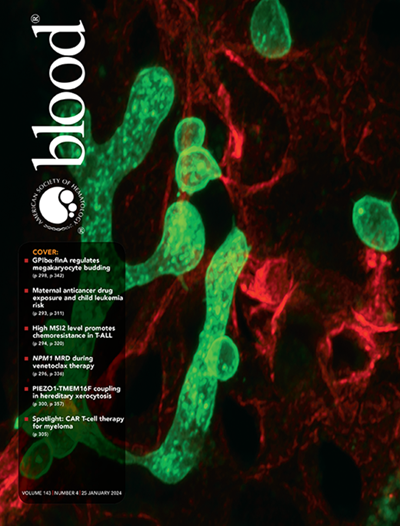Domain and Residue Mapping of Autoantibodies to β2GPI Reveals Differences Among Antiphospholipid Syndrome Phenotypes.
IF 23.1
1区 医学
Q1 HEMATOLOGY
引用次数: 0
Abstract
Antiphospholipid antibodies targeting b2-glycoprotein I (b2GPI) are a hallmark of antiphospholipid syndrome (APS), associated with an increased risk of thrombosis and pregnancy morbidity. Among these, antibodies targeting Domain I (DI) are common in individuals at higher risk; however, their epitopes and prevalence among APS phenotypes remain unclear. Here, we employ a large collection of 29 structurally and functionally validated b2GPI variants to provide new insights into the molecular mechanisms of autoantibody recognition in APS. Using the prototypic human-derived monoclonal anti-DI antibody MBB2, we identified positively charged residue R39 as the key driver for MBB2 binding, followed by residues R43, N56, and T57. Structural analyses revealed that, while R39 is solvent-exposed, R43 is not, as it is caged by residues N56 and T57. The narrow epitope footprint explains why MBB2 exhibits a modest affinity for soluble b2GPI. The cage structure accounts for the epitope being conformational rather than linear. Mutational analyses of IgG anti-b2GPI antibodies from 52 triple-positive APS patients, 37 with a history of thrombosis and 15 non-vascular obstetric patients, confirmed significant reactivity against DI and showed signatures of two conformational epitopes: one similar to MBB2 (epitope I), in which the presence of R39 is essential, and another that does not require R39 (epitope II). While less frequent than epitope-II in our cohort, epitope-I reactivity was notably enriched in thrombotic obstetric patients. Varying epitope specificities for DI may therefore aid in identifying different APS phenotypes and predicting clinical outcomes.β2GPI自身抗体的结构域和残基定位揭示了抗磷脂综合征表型的差异
针对b2糖蛋白I (b2GPI)的抗磷脂抗体是抗磷脂综合征(APS)的标志,与血栓形成和妊娠发病率增加相关。其中,针对结构域I (DI)的抗体在高危人群中较为常见;然而,它们的表位和在APS表型中的流行率尚不清楚。在这里,我们使用了大量的29个结构和功能验证的b2GPI变体,为APS中自身抗体识别的分子机制提供了新的见解。利用人源性单克隆抗di抗体MBB2,我们发现带正电的残基R39是MBB2结合的关键驱动因子,其次是残基R43、N56和T57。结构分析表明,R39是溶剂暴露的,而R43不是,因为它是由残留物N56和T57笼。狭窄的表位足迹解释了为什么MBB2对可溶性b2GPI表现出适度的亲和力。笼状结构说明表位是构象的而不是线性的。对52例三阳性APS患者(37例有血栓病史和15例无血管产科患者)的IgG抗b2gpi抗体进行突变分析,证实了对DI的显著反应性,并显示出两个构象表位的特征:一个类似于MBB2(表位I),其中R39的存在是必需的,另一个不需要R39(表位II)。虽然在我们的队列中,表位- 1的反应性比表位- 2少,但在血栓性产科患者中,表位- 1的反应性明显增强。因此,DI的不同表位特异性可能有助于识别不同的APS表型和预测临床结果。
本文章由计算机程序翻译,如有差异,请以英文原文为准。
求助全文
约1分钟内获得全文
求助全文
来源期刊

Blood
医学-血液学
CiteScore
23.60
自引率
3.90%
发文量
955
审稿时长
1 months
期刊介绍:
Blood, the official journal of the American Society of Hematology, published online and in print, provides an international forum for the publication of original articles describing basic laboratory, translational, and clinical investigations in hematology. Primary research articles will be published under the following scientific categories: Clinical Trials and Observations; Gene Therapy; Hematopoiesis and Stem Cells; Immunobiology and Immunotherapy scope; Myeloid Neoplasia; Lymphoid Neoplasia; Phagocytes, Granulocytes and Myelopoiesis; Platelets and Thrombopoiesis; Red Cells, Iron and Erythropoiesis; Thrombosis and Hemostasis; Transfusion Medicine; Transplantation; and Vascular Biology. Papers can be listed under more than one category as appropriate.
 求助内容:
求助内容: 应助结果提醒方式:
应助结果提醒方式:


